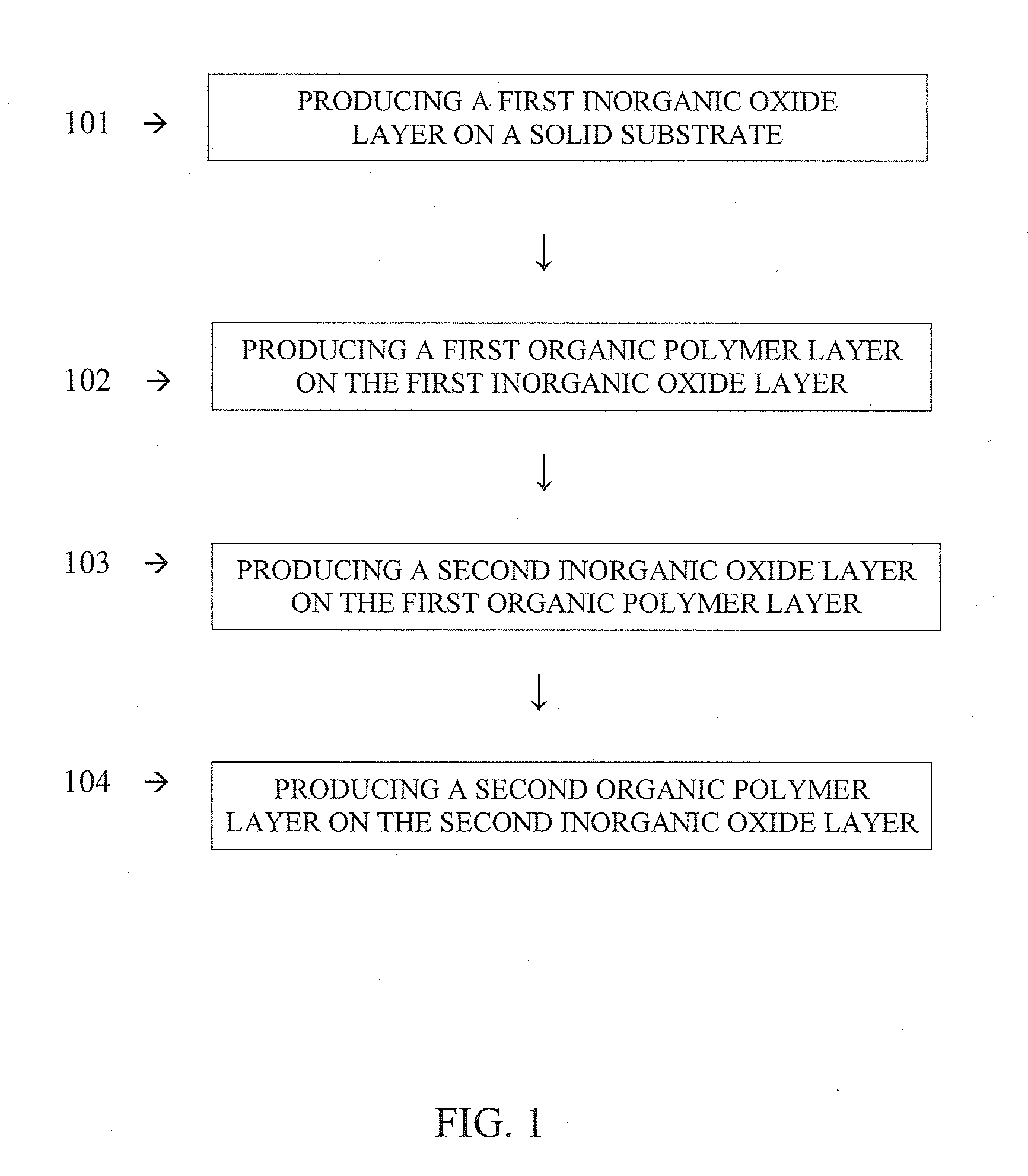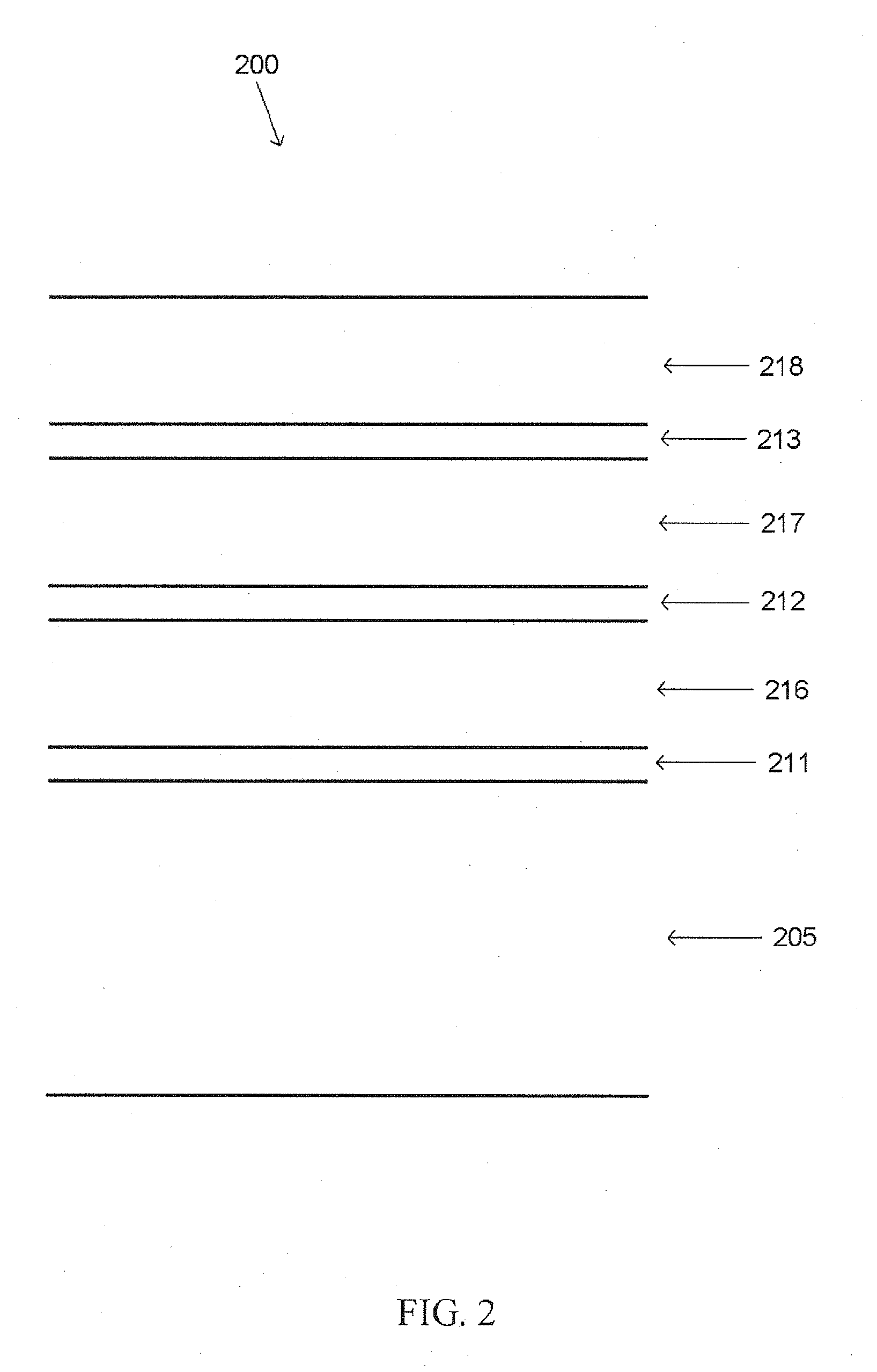Multilayer heterostructures and their manufacture
a heterostructure and multi-layer technology, applied in the field of multi-layer heterostructures and their manufacture, can solve the problems of limiting the utility of the low pressure deposition process for some applications, requiring relatively high temperatures, and slow speed and incompatibility of known low pressure deposition processes
- Summary
- Abstract
- Description
- Claims
- Application Information
AI Technical Summary
Problems solved by technology
Method used
Image
Examples
example 1
An exemplary embodiment of making a multilayer heterostructure comprising an inorganic oxide layer and an organic polymer layer is provided in Example 1. The inorganic oxide layer and the organic polymer layer of Example 1 comprise AlOx and polymethylmethacrylate (PMMA), respectively. The processes of Example 1 are carried out at about ambient atmospheric pressure. The ambient atmospheric pressure of Example 1 is about 821 mb. In other embodiments, the ambient atmospheric pressure can be above or below 821 mb, depending on altitude above sea level and other factors.
The AlOx layer of Example 1 is produced on a solid substrate consisting essentially of PEN, using a Mayer rod coating (a solution coating process), as follows: approximately 0.1 to 1.0 mL of 25% by weight Et2AlOEt in toluene is added to 20 mL anhydrous tetrahydrofuran (THF), and the solution thoroughly mixed under inert gas. The resulting Et2AlOEt / THF solution, in which THF acts as a complexing solvent, is used within two...
example 2
Example 2 is an exemplary embodiment of making a multilayer hetero structure comprising an inorganic oxide layer, a solid substrate, and an organic polymer layer. The inorganic oxide layer, the solid substrate, and the organic polymer layer of Example 2 comprise AlOx, PEN, and polymethylmethacrylate (PMMA), respectively.
The method of making a multilayer hetero structure of Example 2 is illustrated in FIG. 1. The operations of Example 2 are carried out at about ambient atmospheric pressure, which is about 821 mb. In other embodiments, ambient atmospheric pressure can be above or below 821 mb, depending on altitude above sea level and other factors.
Referring to FIG. 1, in a first operation 101, an inorganic oxide layer is produced on a solid substrate using a liquid coating process. The first inorganic oxide layer consists essentially of AlOx, and the solid substrate consists essentially of PEN. The solid substrate of Example 2 is flexible at 20° C., being capable of bending 90° aroun...
example 3
An exemplary embodiment of making a multilayer heterostructure comprising an inorganic oxide layer on a solid substrate is provided in Example 3. The inorganic oxide layer of Example 3 comprises TiOx. The processes of Example 3 are carried out at about ambient atmospheric pressure. Ambient atmospheric pressure of Example 3 is about 821 mb.
The TiOx layer is produced on a solid substrate comprising PEN, using spin-casting (a liquid coating process), as follows: 1 mL of titanium diisopropoxide bis(acetylacetonate) is added to 20 mL of anhydrous THF and thoroughly mixed under inert gas. The resulting solution, in which THF acts as a complexing solvent, is 5% (v / v) titanium isopropoxide in THF. The titanium isopropoxide / THF solution is spin-cast at 600 rpm for 3 seconds followed by 60 seconds at 5000 rpm on clean PEN. The resulting film is treated in an oven at 150° C. for 10 minutes to produce a TiOx layer.
PUM
| Property | Measurement | Unit |
|---|---|---|
| Temperature | aaaaa | aaaaa |
| Temperature | aaaaa | aaaaa |
| Temperature | aaaaa | aaaaa |
Abstract
Description
Claims
Application Information
 Login to View More
Login to View More - R&D
- Intellectual Property
- Life Sciences
- Materials
- Tech Scout
- Unparalleled Data Quality
- Higher Quality Content
- 60% Fewer Hallucinations
Browse by: Latest US Patents, China's latest patents, Technical Efficacy Thesaurus, Application Domain, Technology Topic, Popular Technical Reports.
© 2025 PatSnap. All rights reserved.Legal|Privacy policy|Modern Slavery Act Transparency Statement|Sitemap|About US| Contact US: help@patsnap.com



